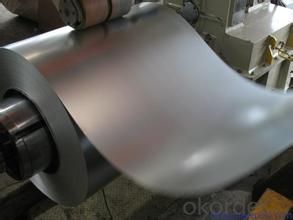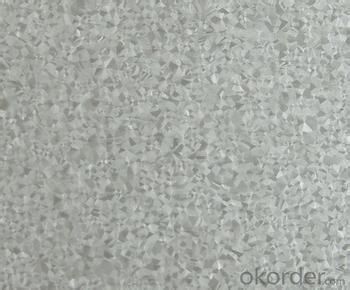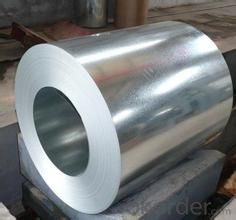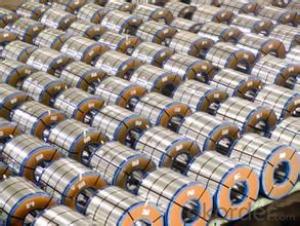Chinese Cheap Hot-dip Aluzinc Steel Building Roof Walls
- Loading Port:
- China main port
- Payment Terms:
- TT OR LC
- Min Order Qty:
- 50 m.t.
- Supply Capability:
- 10000 m.t./month
OKorder Service Pledge
OKorder Financial Service
You Might Also Like
Hot-dip Aluzinc Steel Building Roof Walls
1. Description of the Hot-dip Aluzinc Steel:
Hot-dip aluzinc steel structure is composed of aluminum-zinc alloy, consisting of 55% aluminum, 43% zinc and 2% at 600 ℃ silicon solidification temperature and composition, the entire structure is made of aluminum - iron - silicon - zinc, to form a dense quaternary crystals an alloy.
Hot-dip aluzinc steel has many excellent features: strong corrosion resistance, is three times the pure galvanized sheet; zinc surface with beautiful flowers, can be used as a building outside board.
Applications of hot-dip aluzinc steel:
1)Building: roof, walls, garages, soundproof walls, pipes and modular housing.
2)Automotive: muffler, exhaust pipes, wiper accessories, fuel tank, truck boxes, etc.
3)Appliances: refrigerator back, gas stove, air conditioners, microwave oven, LCD frame, 4)CRT-proof band, LED backlight, electrical cabinets, etc.
5)Farm: barn, sheds, silos, piping and other greenhouse.
6)Other: breaking heat insulation cover, heat exchangers, dryers, warm water, etc.
2.Main Features of the Hot-dip Aluzinc Steel:
• Excellent corrosion resistance
• High temperature oxidation resistance
• High hot reflectance
• Good manufacturability
•Beautiful appearance
•Surface coating
•Cost-effective
3.Hot-dip Aluzinc Steel Images



4.Hot-dip Aluzinc Steel Specification
AVAILABLE SPECIFICATION
HOT-DIP ALUZINC STEEL COILS | |
THICKNESS | 0.16mm-3.5mm |
WIDTH | 1250mm MAX |
COATING MASS | 30g/ m2-185 g/ m2 |
SPANGLE | Regular Spangle, Minimized Spangle, Zero Spangle |
SURFACE TREATMENT | Chromated / non-chromated, Oiled / non-oiled, Anti Finger Print |
COIL INNER DIAMETER | 508mm or 610mm |
HOT-DIP ALUZINC STEEL COILS | |||
COMMERCIAL QUALITY | ASTM A792M-06a | EN10327-2004 | JIS G 3321:2010 |
STRUCTURE STEEL | SS GRADE 230 SS GRADE 255 SS GRADE 275 SS GRADE 340 SS GRADE 550 | S220GD+AZ S250GD+AZ S280GD+AZ S320GD+AZ S350GD+AZ S550GD+AZ | SGLC400 SGLC440 SGLC490 SGLC570 |
2.5.FAQ of Hot-dip Aluzinc Steel
We have organized several common questions for our clients,may help you sincerely:
1.What advantages does your company have?
Cement : Annual capacity of 400 million tons, No. 1 in the world
Fiberglass: Annual capacity of 1 million tons fiberglass, No. 1 in the world.
Composite Materials — Carbon Fiber: Annual capacity of 10,000 tons PAN precursor and 4,000 tons carbon fiber, No. 1 in China
Composite Materials — Rotor Blade: Annual production capacity of 15,000 pieces, No.1 in China, Top3 worldwide
Glass: CNBM owns about 20 modern float glass product`ion lines, With annual capacity of 10 million square meters glass.
Light Weight Building Materials: Annual capacity of 1.65 billion square meters of gypsum board, No. 1 in the world.
Commercial concrete: Annual capacity of 0.35 billion cubic meters, No. 1 in the world.
Refractory Material: Annual capacity of 40,000 tons casting refractory, No.1 in the world.
2.What advantages do your products have?
Firstly, our base material is of high quality, Their performance is in smooth and flat surface,no edge wave ,good flexibility.
Secondly, high quality zinc ingoats, 97.5% zinc,1.5% silicon,1% others, the same zinc coating measured by metal coating thickness or by zinc weight
Thirdly, high precision: Tolerance strictly according to ASTM or JISG standard even more rigid.
We have full stes of testing equipment(for t best, cupule,chromatism,salt spray resistance, etc) and professional engineers.
- Q:What is the role of steel coils in the electrical industry?
- Steel coils play a crucial role in the electrical industry as they are used in the manufacturing of various electrical components and equipment. These coils are typically made of high-quality steel and are used in transformers, motors, generators, and other electrical devices. They provide structural support and act as a core for the electromagnetic field required for the functioning of these devices. Additionally, steel coils are also used in the production of magnetic cores, which are essential for efficient energy transfer and storage in electrical systems. Overall, steel coils are integral to the electrical industry, enabling the efficient and reliable operation of electrical equipment.
- Q:How are steel coils inspected for dimensional accuracy during processing?
- Steel coils are inspected for dimensional accuracy during processing using various methods such as laser measuring systems, ultrasonic thickness gauges, and calipers. These tools are used to measure the width, thickness, and diameter of the coils to ensure they meet the required specifications. Additionally, visual inspections are also conducted to identify any irregularities or defects in the coils.
- Q:I thought it was STAINLESS STEEL! I have stainless steel can openers spatulas that are rusty. What's up with that? did you know that braces on people's teeth are made of stainless steel? That's why they call people metal-mouth. I used to have braces.
- steel is a iron alloy with composites like carbon and with a minimum chromium percentage of 10.5 ...and the strength and other properties are closely related to the percentage of carbon and chromium used in it..! its the chromium that creates a thin oxide layer maintaining the lustre by preventing the alloy from forming the iron oxide which is often reffered as rust..so if you got your stainless steel rusted you are betryed by the manufactures and may be they have failed to anticipate the sorrounding environment so that they selected a compostion that best suits..!! cheers..!
- Q:it isn't a SIGG water bottle or any other brand, as it's from thingsengraved what I'm wondering is, is this just as good as a SIGG water bottle, or is there any difference?
- Should be OK- that's reputable vendor. Suggest initial flush insides with very mild acid (fill ~20% with mild vinegar, Pepsi, etc., then shake 1 minute) then rinse 2 times, then look inside to confirm it looks clean.
- Q:What are the different methods of tension leveling for steel coils?
- There are various techniques available for tension leveling steel coils, each with its own benefits and applications. 1. Roller leveling: By passing the steel coil through a series of rollers under high tension, strategically positioned to exert pressure on the coil, this method effectively stretches and elongates the coil. It is commonly used for thinner gauge coils and effectively eliminates defects such as coil set, crossbow, and edge wave. 2. Stretch leveling: This technique involves subjecting the steel coil to a combination of tension and elongation. The coil is held by clamps at both ends and then stretched using hydraulic or mechanical devices. This process helps remove residual stresses, flatten the coil, and enhance shape control. Stretch leveling is particularly suitable for thicker gauge coils, effectively eliminating wavy edges and center buckle. 3. Temper rolling: By passing the steel coil through a series of temper rolls that apply pressure on the surface, this method is primarily used to improve the surface finish and enhance the mechanical properties of the steel. It also helps reduce coil set and improve flatness. 4. Skin pass rolling: After the primary leveling process, the steel coil is passed through a series of rolls that apply light pressure on the surface. This technique is typically performed to further improve surface finish, enhance flatness, and reduce surface defects such as scratches or marks. 5. Stretcher leveling: This technique involves clamping the steel coil at both ends and applying tension to stretch it. The stretched coil is then held in this position for a specific duration to allow for stress relief and shape correction. It is commonly used for thicker gauge coils and effectively removes defects like coil set, crossbow, and center buckle. Each tension leveling method offers distinct advantages and is suitable for different types of steel coils and specific requirements. The choice of method depends on factors such as coil thickness, desired flatness, surface finish, and the specific defects that need to be corrected.
- Q:How do steel coils contribute to the renewable energy equipment industry?
- Steel coils contribute to the renewable energy equipment industry by playing a crucial role in the manufacturing of various renewable energy components. They are used to create structural frames, support structures, and brackets for wind turbines, solar panels, and other renewable energy systems. Additionally, steel coils are essential in the production of electrical transformers and transmission lines, which are integral to the distribution of renewable energy. Overall, steel coils provide the strength, stability, and durability required for the efficient and long-lasting operation of renewable energy equipment.
- Q:What are the common applications of galvanized steel coils?
- Galvanized steel coils are commonly used in a variety of applications, including construction, automotive manufacturing, electrical appliances, and agricultural equipment. They are particularly useful for roofing and siding materials, as well as for creating durable and corrosion-resistant components in various industries.
- Q:What are the main factors that affect the surface quality of steel coils?
- The main factors that affect the surface quality of steel coils include the cleanliness of the steel surface, the presence of any defects or imperfections, the level of surface roughness, the coating or finishing applied to the surface, and the handling and storage conditions of the coils.
- Q:How are steel coils used in the production of metal facades?
- Steel coils are used in the production of metal facades as the primary material. These coils are unwound and then processed through various manufacturing techniques, such as cutting, shaping, and forming, to create the desired facade panels. The steel coils provide strength, durability, and versatility, allowing for the creation of aesthetically pleasing and functional metal facades in various architectural applications.
- Q:Can steel coils be coated with thermally insulating materials?
- Yes, steel coils can be coated with thermally insulating materials. These materials help to reduce heat transfer and provide insulation to the steel coils, enhancing their thermal resistance.
1. Manufacturer Overview |
|
|---|---|
| Location | |
| Year Established | |
| Annual Output Value | |
| Main Markets | |
| Company Certifications | |
2. Manufacturer Certificates |
|
|---|---|
| a) Certification Name | |
| Range | |
| Reference | |
| Validity Period | |
3. Manufacturer Capability |
|
|---|---|
| a)Trade Capacity | |
| Nearest Port | |
| Export Percentage | |
| No.of Employees in Trade Department | |
| Language Spoken: | |
| b)Factory Information | |
| Factory Size: | |
| No. of Production Lines | |
| Contract Manufacturing | |
| Product Price Range | |
Send your message to us
Chinese Cheap Hot-dip Aluzinc Steel Building Roof Walls
- Loading Port:
- China main port
- Payment Terms:
- TT OR LC
- Min Order Qty:
- 50 m.t.
- Supply Capability:
- 10000 m.t./month
OKorder Service Pledge
OKorder Financial Service
Similar products
New products
Hot products
Hot Searches
Related keywords






























